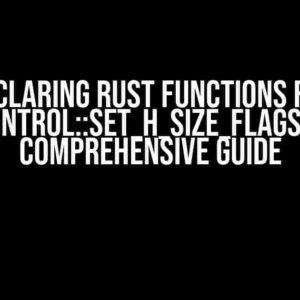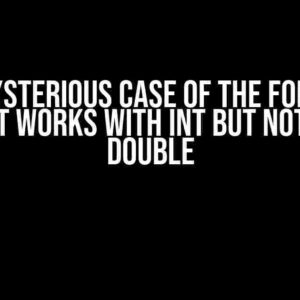When working with maps in programming, you often need to create a type that matches the map’s value. This can be a bit tricky, but don’t worry, we’ve got you covered! In this article, we’ll take you by the hand and walk you through the process of creating a type that matches a map’s value.
What is a Map?
Before we dive into the meat of the article, let’s take a quick detour to explain what a map is. In programming, a map (also known as a dictionary or associative array) is a data structure that stores a collection of key-value pairs. Each key is unique, and it’s used to access the corresponding value. Maps are useful when you need to store data that has a complex structure or when you need to quickly look up values by their keys.
Why Do I Need to Create a Type That Matches a Map’s Value?
So, why do you need to create a type that matches a map’s value? Well, there are several reasons:
- Type Safety: By creating a type that matches a map’s value, you ensure that the value is always valid and consistent. This helps prevent errors and makes your code more reliable.
- Code Readability: When you create a type that matches a map’s value, you make your code more readable and understandable. It’s easier to understand the structure of the data and how it’s used.
- Code Reusability: By creating a reusable type that matches a map’s value, you can reuse it throughout your codebase, reducing code duplication and making your code more maintainable.
How to Create a Type That Matches a Map’s Value: A Step-by-Step Guide
Now that we’ve covered the why, let’s get to the how! Here’s a step-by-step guide on how to create a type that matches a map’s value:
Step 1: Identify the Map’s Value Type
The first step is to identify the type of the map’s value. This might seem obvious, but it’s crucial to get this right. Look at the map declaration and identify the type of the value. For example, let’s say you have a map declared like this:
const myMap: Map<string, { name: string, age: number }> = new Map();In this example, the map’s value type is an object with two properties: `name` and `age`. The `name` property is a string, and the `age` property is a number.
Step 2: Create an Interface for the Value Type
Now that you’ve identified the map’s value type, create an interface for it. An interface is a way to define a shape of an object in TypeScript (or JavaScript). It’s a blueprint that describes the properties and methods of an object.
interface ValueType {
name: string;
age: number;
}In this example, we’ve created an interface called `ValueType` that matches the shape of the map’s value.
Step 3: Create a Type Alias for the Map’s Value
A type alias is a way to give a new name to an existing type. In this case, we’ll create a type alias for the map’s value type. This will make it easier to use the type throughout our code.
type MapValueType = ValueType;In this example, we’ve created a type alias called `MapValueType` that references the `ValueType` interface.
Step 4: Use the Type Alias in Your Code
Now that you’ve created the type alias, use it in your code. For example, let’s say you want to create a function that takes a map’s value as an argument:
function processMapValue(value: MapValueType) {
console.log(value.name);
console.log(value.age);
}In this example, we’ve created a function called `processMapValue` that takes a single argument of type `MapValueType`. This ensures that the function can only be called with a value that matches the shape of the map’s value.
Example Scenarios
Let’s look at a few example scenarios to illustrate how to create a type that matches a map’s value:
Scenario 1: Map with String Values
Let’s say you have a map declared like this:
const stringMap: Map<string, string> = new Map();In this case, the map’s value type is a string. You can create a type alias like this:
type StringValueType = string;Scenario 2: Map with Object Values
Let’s say you have a map declared like this:
const objectMap: Map<string, { id: number, name: string }> = new Map();In this case, the map’s value type is an object with two properties: `id` and `name`. You can create an interface and a type alias like this:
interface ObjectValueType {
id: number;
name: string;
}
type MapValueType = ObjectValueType;Scenario 3: Map with Array Values
Let’s say you have a map declared like this:
const arrayMap: Map<string, number[]> = new Map();In this case, the map’s value type is an array of numbers. You can create a type alias like this:
type ArrayValueType = number[];Common Pitfalls to Avoid
When creating a type that matches a map’s value, there are a few common pitfalls to avoid:
- Not defining the type correctly: Make sure you correctly define the type of the map’s value. This includes ensuring that the type is accurate and complete.
- Not using the type consistently: Once you’ve created the type, use it consistently throughout your code. This helps maintain code readability and prevents errors.
- Not considering edge cases: Always consider edge cases when creating a type that matches a map’s value. This includes handling null or undefined values, as well as unexpected data shapes.
Conclusion
Creating a type that matches a map’s value is an essential skill for any programmer. By following the steps outlined in this article, you can ensure that your code is type-safe, readable, and maintainable. Remember to identify the map’s value type, create an interface for it, create a type alias, and use the type alias consistently throughout your code. With practice and patience, you’ll become a master of creating types that match map values!
| Scenario | Map Declaration | Type Alias |
|---|---|---|
| Map with String Values | const stringMap: Map<string, string> = new Map(); |
type StringValueType = string; |
| Map with Object Values | const objectMap: Map<string, { id: number, name: string }> = new Map(); |
interface ObjectValueType { id: number; name: string; } type MapValueType = ObjectValueType; |
| Map with Array Values | const arrayMap: Map<string, number[]> = new Map(); |
type ArrayValueType = number[]; |
Frequently Asked Question
Are you wondering how to create a type that matches a Map’s value? Look no further! Here are some frequently asked questions and answers to help you out.
What is the purpose of creating a type that matches a Map’s value?
Creating a type that matches a Map’s value is useful when you want to ensure that the values in your Map conform to a specific structure or format. This can help with data validation, readability, and maintainability.
How do I create a type that matches a Map’s value using TypeScript?
In TypeScript, you can use the `Record` type to create a type that matches a Map’s value. For example, if you have a Map with string keys and values of type `number`, you can create a type like this: `type MyType = Record
What if my Map values are objects with specific properties?
If your Map values are objects with specific properties, you can create an interface or type that defines the structure of those objects. Then, you can use the `Record` type with that interface or type as the value type. For example: `interface MyValueType { foo: string; bar: number }; type MyType = Record
Can I use this approach with other programming languages?
While the `Record` type is specific to TypeScript, the concept of creating a type that matches a Map’s value can be applied to other programming languages that support generics or type systems. For example, in Java, you can use a `Map
What are the benefits of creating a type that matches a Map’s value?
Creating a type that matches a Map’s value can help with code readability, maintainability, and error prevention. By defining a specific type for your Map values, you can ensure that your code is more predictable and easier to understand, and catch type-related errors at compile-time rather than runtime.



